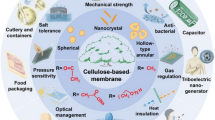Abstract
Nano-crystalline cellulose (NCC) with high content of Iα domains are generated by treatment of cellulose microfibrils from the algae Chaetomorpha antennina with 80 % H2SO4 followed by ethanolic precipitation. X-ray diffraction and FT-IR analyses have revealed that the NCCs produced are highly crystalline and predominantly composed of the Iα allomorph, which indicate the selective dissolution of Iα fragments. AFM images shows that the NCCs produced are of 60–70-nm thickness and of variable length depending on the concentration. The well-dispersed suspension of 1-mg NCC in 10-mL distilled water shows a highly networked structure, which expand its applications over various fields especially in nano-medicine.






Similar content being viewed by others
References
Sÿturcova, I. H., Apperley, D. C., Sugiyama, J., Jarvis, M. C. (2004). Structural details of crystalline cellulose from higher plants. Biomacromolecules, 5, 1333–1339.
Imai, T., Boisset, C., Samejima, M., Igarashi, K., Sugiyama, J. (1998). Unidirectional processive action of cellobiohydrolase Cel7A on Valonia cellulose microcrystals. FEBS Letters, 432, 113–116.
Klemm, D., Heublein, B., Fink, H. P., Bohn, A. (2005). Cellulose: fascinating biopoly-mer and sustainable raw material. Angewandte Chemie International Edition, 44, 3358–3393.
Sugiyama, J., Persson, J., Chanzy, H. (1991). Combined Infrared and Electron Diffraction Study of the polymorphism of native celluloses. Macromolecules, 24, 2461–2466.
Horii, F., Hirai, A., Kitamaru, R. (1987). CP/MAS 13C NMR spectra of the crystalline components of native cellulose. Macromolecules, 20, 2117–2120.
Hayashi, N., Ishihara, M., Sugiyama, J., Okano, T. (1998). The enzymatic susceptibility of cellulose microfibrils of the algal-bacterial type and cotton-ramie type. Carbohydrate Research, 305, 109–116.
Yoshiharu, N., Paul, L., Henri, C. (2002). Crystal structure and hydrogen-bonding system in cellulose Iβ from synchrotron x-ray and neutron fiber diffraction. Journal of American Chemical Society, 124, 9074–9082.
Sugiyama, J., Okano, T., Yamamoto, H., Horii, F. (1990). Transformation of Valonia cellulose crystals by an alkaline hydrothermal treatment. Macromolecules, 23, 3196–3198.
Hayashia, N., Kondob, T., Ishiharaa, M. (2005). Enzymatically produced nano-ordered short elements containing cellulose I β crystalline domains. Carbohydrate Polymers, 61, 191–197.
Nishiyama, Y., Sugiyama, J., Chanzy, H., Langan, P. (2003). Crystal structure and hydrogen bonding system in cellulose Iα from synchrotron x-ray and neutron fiber diffraction. Journal of American Chemical Society, 125, 47.
Jackson, J. K., Letchford, K., Wasserman, B. Z., Ye, L., Hamad, W. Y., Burt, H. M. (2011). The use of nanocrystalline cellulose for the binding and controlled release of drugs. International Journal of Nanomedicine, 6, 321–330.
Yamamoto, H., Horii, F., Hirai, A. (1996). In situ crystallization of bacterial cellulose II. Influences of different polymeric additives on the formation of celluloses Iα and Iβ at the early stage of incubation. Cellulose, 3, 229–242.
Wada, M., Okano, T., Sugiyama, J. (1997). Synchroton radiated x-ray and neutron diffraction study of native cellulose. Cellulose, 3, 221–232.
Elazzouzi-Hafraoui, S., Nishiyama, Y., Putaux, J., Heux, L., Dubrueil, F., Rochas, C. (2008). The shape and size distribution of crystalline nanoparticles prepared by acid hydrolysis of native cellulose. Biomacromolecules, 9, 57–65.
Mihranyan, A. (2011). Cellulose from Cladophorales green algae: from environmental problem to high-tech composite materials. Journal of Applied Polymer Science, 119, 2449–2460.
Barsberg, S. (2010). Prediction of vibrational spectra of polysaccharides simulated IR spectrum of cellulose based on density functional theory (DFT). Journal of Physical Chemistry, 11, 11703–11708.
Debzi, E. M., Chanzy, H., Sugiyama, J., Tekely, P., Excoffier, G. (1991). The Iα/Iβ transformation of highly crystalline cellulose by annealing in various mediums. Macromolecules, 24, 6816–6822.
Kose, R., Mitani, I., Kasai, W., Kondo, N. (2011). Nanocelluloseas a single nanofiber prepared from pellicle secreted by Gluconacetobacter xylinus using aqueous counter collision. Biomacromolecules, 12, 716–720.
Yamamoto, H., Horii, F., Odani, H. (1989). Structural changes of native cellulose crystals induced by annealing in aqueous alkaline and acidic solutions at high temperatures. Macromolecules, 22, 4130–4132.
Esrafili, M. D., & Ahmadin, H. (2012). DFT study of 17O, 1H and 13C NMR chemical shifts in two forms of native cellulose, Iα and Iβ. Carbohydrate Research, 347, 99–106.
Desiraju, G. R., & Steiner, T. (1999). The weak hydrogen bond. New York: Oxford University Press.
Kalita, R. D., Natha, Y., Ochubiojoa, M. E., Buragohain, A. K. (2013). Extraction and characterization of microcrystalline cellulose from fodder grass, Setaria glauca (L) P. Beauv, and its potential as a drug delivery vehicle for isoniazid, a first line antituberculosis drug. Colloids and Surfaces B, 108, 85–89.
Kaboorani, A., Riedl, B., Blanchet, P., Fellin, M., Hosseinaei, O., Wang, S. (2012). Nanocrystalline cellulose (NCC): a renewable nano-material for polyvinyl acetate (PVA) adhesive. European Polymer Journal, 48, 1829–1837.
Acknowledgments
One of the authors (SS) is grateful to the financial assistance by CSIR (India). We thank Prof. Jayaraj M.K., department of physics, CUSAT for providing the instrumental facilities, and the Government of Kerala for the financial support received to establish a new centre, Inter University Centre for Development of Marine Biotechnology (IUCDMB).
Author information
Authors and Affiliations
Corresponding author
Rights and permissions
About this article
Cite this article
Saritha, S., Nair, S. & Kumar, N. Nano-Ordered Cellulose Containing Iα Crystalline Domains Derived from the Algae Chaetomorpha antennina . BioNanoSci. 3, 423–427 (2013). https://doi.org/10.1007/s12668-013-0110-9
Published:
Issue Date:
DOI: https://doi.org/10.1007/s12668-013-0110-9




